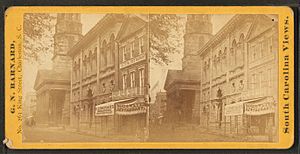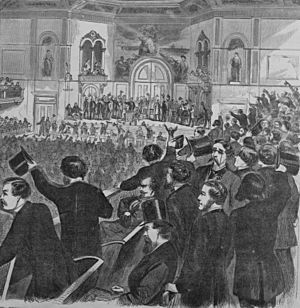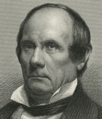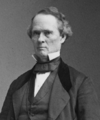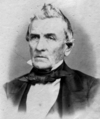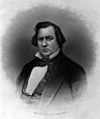1860 Democratic National Conventions facts for kids
| 1860 presidential election |
|
| Conventions | |
|---|---|
| Date(s) | April 23–May 3, 1860 & June 18–23, 1860 |
| City | Charleston, South Carolina & Baltimore, Maryland |
| Venue | South Carolina Institute Hall, Front Street Theater & Maryland Institute (Southern) |
| Candidates | |
| Presidential nominee | Stephen A. Douglas of Illinois (Official) John C. Breckinridge of Kentucky (Southern) |
| Vice presidential nominee | Herschel V. Johnson of Georgia (Official) Joseph Lane of Oregon (Southern) |
The 1860 Democratic National Conventions were important meetings where the Democratic Party chose its candidates for president and vice president for the 1860 election. The first meeting happened in Charleston, South Carolina, from April 23 to May 3, 1860. It didn't pick any candidates. Later, two more meetings took place in Baltimore, Maryland, in June. These meetings ended up choosing two different sets of candidates for the party.
Senator Stephen A. Douglas from Illinois was the top choice for president at the Charleston meeting. He won the most votes, but the rules said he needed two-thirds of all votes to win. Many delegates from the Southern states strongly disagreed with Douglas's ideas about slavery in new territories. They supported other candidates. After 57 votes over 10 days, Douglas still couldn't get enough votes, so the Charleston meeting stopped without picking anyone.
The Democratic Party met again in Baltimore on June 18. Many Southern delegates either didn't show up or left in protest. This happened because the party agreed to follow the Supreme Court of the United States's decisions about slavery. Douglas was finally chosen as the presidential candidate. Senator Benjamin Fitzpatrick was picked for vice president, but he said no. So, former Governor Herschel V. Johnson of Georgia took his place.
The Southern Democrats who had left or boycotted the main meeting held their own convention. They chose a platform that strongly supported slavery. They picked Vice President John C. Breckinridge for president and Senator Joseph Lane for vice president. In the 1860 election, Douglas and Breckinridge together got almost half of the votes. However, they both lost to the Republican candidate, Abraham Lincoln.
Contents
Charleston Convention: A Big Disagreement
The 1860 Democratic National Convention started in Charleston, South Carolina, on April 23, 1860. The meeting was held at South Carolina Institute Hall. Charleston was a very pro-slavery city at the time. Because of this, the audience at the convention was full of people who supported slavery.
Why Stephen Douglas Was a Problem
The main candidate for president was Stephen Douglas. He was seen as a moderate on the issue of slavery. In 1854, Douglas introduced the Kansas–Nebraska Act. This law allowed settlers in each territory to decide for themselves if slavery would be allowed. This was called popular sovereignty. It was different from the Missouri Compromise, which had banned slavery in most territories. Southern states liked this change.
However, in 1857, the Supreme Court made the Dred Scott decision. This ruling said that the Constitution protected slavery in all territories. This made Douglas's idea of popular sovereignty much less powerful.
In 1858, Douglas ran for his Senate seat against Abraham Lincoln. During their famous debates, Douglas explained his Freeport Doctrine. This idea basically went against the Dred Scott ruling. Many strong pro-slavery Southerners, called "Fire-Eaters" like William Lowndes Yancey from Alabama, saw Douglas as a traitor. They even thought the Democratic Party would split, which would help the Republican candidate, William H. Seward, win the election.
Southern States Walk Out
Before the convention officially began, delegates from seven Southern states (Georgia, Alabama, Mississippi, Louisiana, Arkansas, Texas, and Florida) met separately. They agreed to try and stop Douglas from becoming president. They planned to create a party platform that strongly supported slavery. They knew Douglas would not be able to run on such a platform.
The committee in charge of the party's platform was led by William Waightstill Avery. This committee, mostly made up of "Fire-eaters," wrote a document that clearly supported slavery. It backed the Dred Scott decision and wanted laws to protect slavery in the territories. Democrats from the Northern states refused to agree to this. They said the Dred Scott decision was very unpopular in the North. They believed they couldn't win any Northern states with such a platform. Winning the presidency without New York or Pennsylvania was very difficult for any candidate.
On April 30, the convention voted to accept the Northern platform, which did not include the strong pro-slavery ideas. Because of this, 50 Southern delegates walked out of the convention in protest. This included all the delegates from Alabama, Florida, Georgia, Louisiana, Mississippi, South Carolina, and Texas. Some delegates from Arkansas and Delaware also left.
These delegates met at St. Andrews Hall and said they were the real convention. Meanwhile, the meeting at Institute Hall continued with nominations. Douglas's supporters thought their path to nomination was now clear.
Who Was Nominated?
Six main candidates were nominated at the Charleston convention:
- Senator Stephen A. Douglas of Illinois
- Former Treasury Secretary James Guthrie of Kentucky
- Senator Robert M. T. Hunter of Virginia
- Senator Joseph Lane of Oregon
- Former Senator Daniel S. Dickinson of New York
- Senator Andrew Johnson of Tennessee
Douglas led the first vote, getting 145.5 out of 253 votes. However, the rules said a candidate needed two-thirds of all members to win, not just two-thirds of those present. This meant Douglas needed 202 votes, which was 56.5 more votes. He would have needed some Southern delegates, who strongly opposed him, to vote for him.
The convention held 57 votes, and Douglas led every time. But he never got more than 152.5 votes. On May 3, the delegates decided to stop the convention and meet again in Baltimore six weeks later.
Baltimore Convention: A New Attempt
The Democrats met again at the Front Street Theater in Baltimore, Maryland, on June 18. The first thing they had to decide was whether to let the delegates who had walked out of the Charleston meeting come back. They also had to decide if new delegates, chosen by Douglas supporters in some states, should be allowed to join. Some delegates had simply boycotted the Baltimore meeting.
The committee that checked delegates' credentials suggested letting all delegates back in, except those from Louisiana and Alabama. Another report suggested letting some of the Louisiana and Alabama delegates return. The convention voted to accept the first report. After new delegates from Louisiana and Alabama were seated, 56 more delegates walked out in protest. Most of these were from the South, with a few from Northern and Western states.
Choosing a President
After the walkouts, the convention started voting for a presidential candidate. The following people received votes:
- Senator Stephen A. Douglas of Illinois
- Former Secretary of the Treasury James Guthrie of Kentucky
- Former Senator Daniel S. Dickinson of New York
- Former Governor Horatio Seymour of New York
Douglas received 173.5 out of 190.5 votes on the first ballot (which was the 58th overall). On the second ballot (the 59th overall), he got 181.5 out of 194.5 votes.
After checking the votes, it was clear that only 194.5 delegates were present. This meant Douglas still couldn't get the 202 votes needed under the old rule. The delegates then voted to get rid of that rule. After that, it was announced that Douglas had received the required two-thirds of the votes cast. He was officially nominated as the presidential candidate.
Choosing a Vice President
Senator Benjamin Fitzpatrick of Alabama was the only person nominated for vice president. He received 198.5 votes. However, he later refused the nomination. This has only happened two other times in U.S. history.
Since no vice-presidential candidate was chosen at the convention, Douglas offered the nomination to former Senator and Governor Herschel V. Johnson of Georgia. Johnson accepted.
"Breckinridge Democrats" Convention
The Southern Democrats who had walked out or boycotted the main convention met separately at the Maryland Institute in Baltimore. This rival convention adopted a platform that strongly supported slavery. They nominated John C. Breckinridge for president.
Joseph Lane was nominated for vice president by a voice vote, meaning everyone agreed without a formal ballot.
What Happened Next
After the Charleston convention broke apart, many people believed that the Republicans were sure to win the 1860 Presidential election.
In the actual election, the split in the Democratic votes didn't change the outcome in most states. However, it did affect California, Oregon, Kentucky, Tennessee, and Virginia. California and Oregon were free states and were won by the Republican candidate, Abraham Lincoln. The other three were slave states. They were won by John Bell, the candidate for the Constitutional Union Party. This party was mostly made up of former Whigs and tried to ignore the slavery issue to focus on keeping the country together.
Even if all the votes for Douglas, Breckinridge, and Bell had gone to one candidate, Lincoln would still have won a large majority of electoral votes. However, the split in the Democratic Party definitely hurt their chances in many states, especially Pennsylvania. Pennsylvania's 27 electoral votes were very important for Lincoln's victory. If he hadn't won Pennsylvania and one other free state, he wouldn't have had enough electoral votes. This would have meant the House of Representatives would have had to choose the president.
Some historians, like James M. McPherson in his book Battle Cry of Freedom, suggest that the "Fire-eaters" deliberately broke up the convention. Their goal might have been to help a Republican win the presidency. This would then cause the slave-owning states to declare their independence from the Union. Whatever their true intentions, their actions certainly split the Democratic Party. This almost guaranteed a Republican victory, which then led to states leaving the Union.
Images for kids
-
Senator Stephen A. Douglas of Illinois
-
Former Secretary of the Treasury James Guthrie of Kentucky
-
Senator Joseph Lane of Oregon
-
Senator Andrew Johnson of Tennessee
-
Former Governor Horatio Seymour of New York
-
John C. Breckinridge for President


